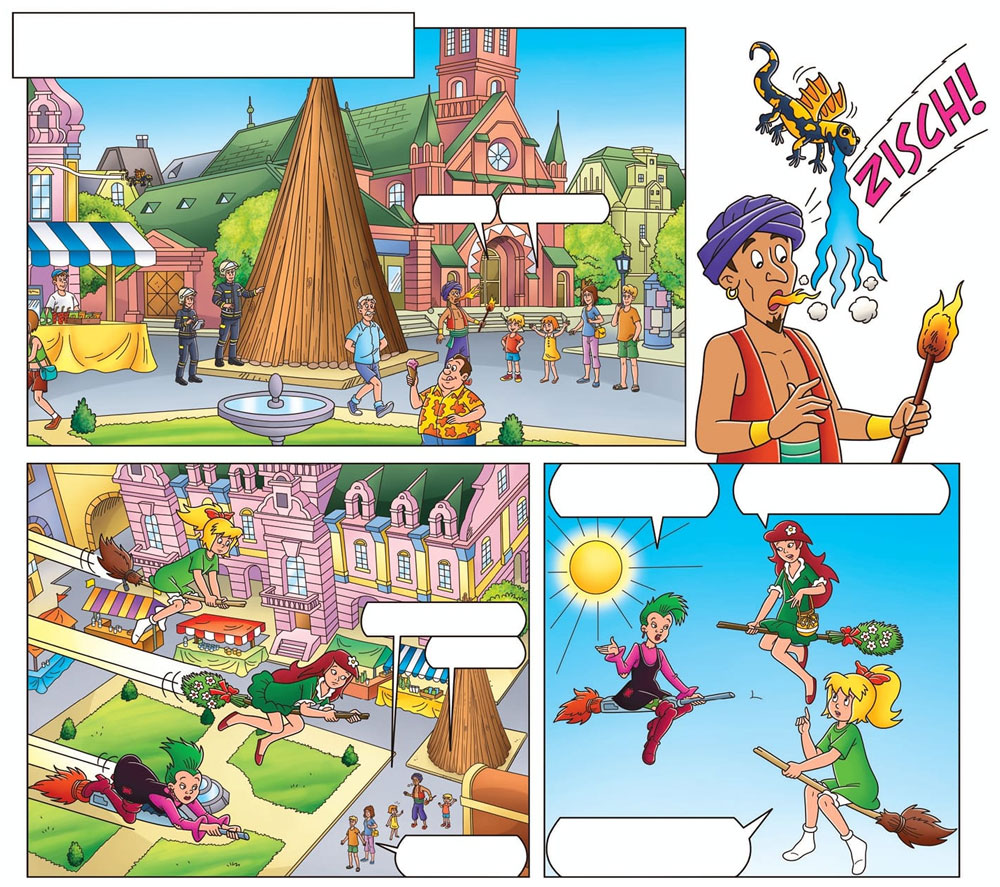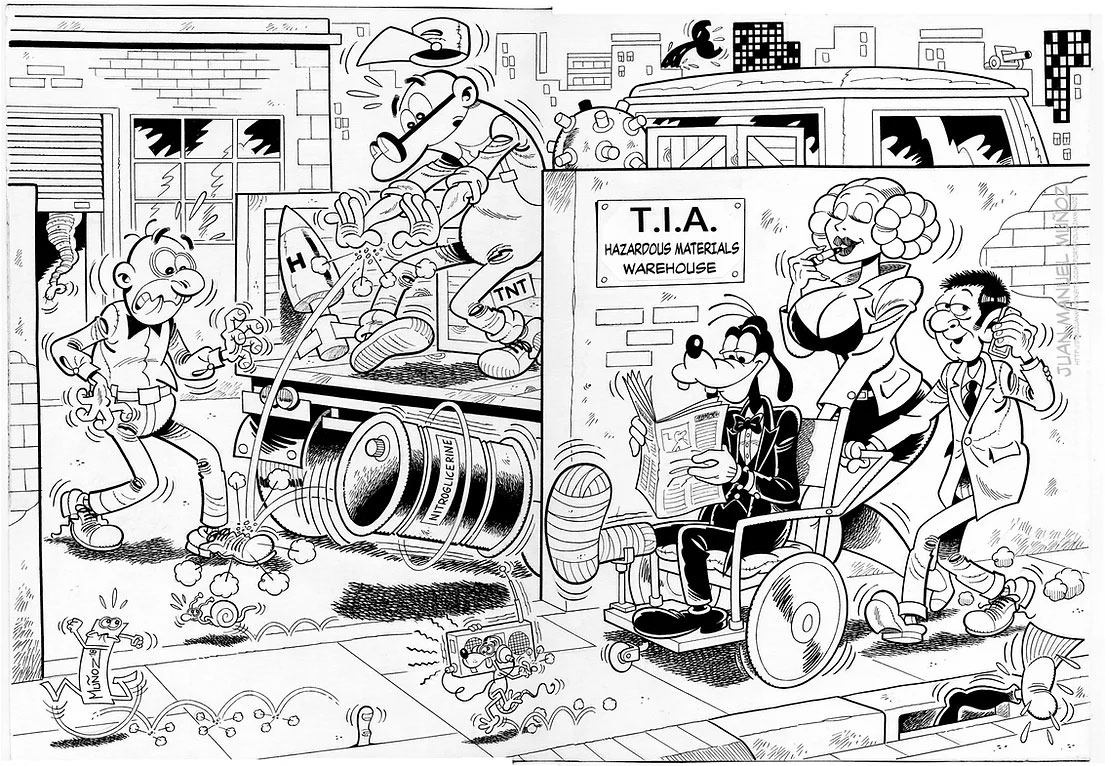Mortadelo y Filemón - 'A la Caza del Chotta' (1985), pencils by Juan M. Muñoz.
Juan Manuel Muñoz Chueca - Juan M. Muñoz in short - was the longtime assistant of Francisco Ibáñez on the 'Mortadelo y Filemón' series, working for many decades as clean-up artist and inker. In between and afterwards, he has done agency work on the Swedish 'Bamse' comic books, the Danish production of Disney comics and the German 'Bibi Blocksberg' magazine.
Early life and career
Born in 1961, Juan Manuel Muñoz Chueca grew up reading many of the comic books that were available in Spain at the time. These included adventure comics like Victor Mora and Ambros' 'El Capitán Trueno' and Mora and Francisco Darnis' 'El Jabato', translations of Marvel superhero comics and Bruguera humor magazines like Din Dan, Mortadelo, DDT and Pulgarcito. As a teenager, between 1975 and 1980, he studied industrial art at the Escuela La Salle in Barcelona. Since his childhood, Muñoz had been an avid draftsman himself. When he was sixteen years old, his father encouraged him to present his work to the publishing house Bruguera, at the time one of the largest publishers of comic magazines in Spain.
In 1978, Bruguera studio chief Blas Sanchís hired the young Muñoz as an inker. Between 1978 and 1984, Muñoz Chueca was part of Bruguera's art team, inking many of the publisher's characters, including José Escobar's 'Zipi y Zape' and the Gustavo Martz-Schmidt creations 'El Profesor Tragacanto' and 'Delirante Rococó'. Between December 1979 and April 1980, Muñoz created his own 'Peques' cartoon panels with kids' humor as a back-up feature in Bruguera's Zipi y Zape publications.
'Peques' cartoon feature, by Juan Muñoz (1980).
Bruguera's Ibáñez productions
In the early 1980s, Juan Manuel Muñoz Chueca began his longtime association with the legendary characters created by Francisco Ibáñez. His first work was penciling and inking 'El Vil Mosquito' a six-page story with the clumsy bellhop 'El Botones Sacarino'. After that, he inked several of the other Ibáñez creations, such as 'Rompetechos', '13, Rue del Percebe', 'Pepe Gotera y Otilio' and, eventually, 'Mortadelo y Filemón'. The first 'Mortadelo' comic inked by Muñoz Chueca was 'Mortadelo El Bacilón' (1983). Known for its slapstick humor and zany plots, this series about two highly incapable secret agents is one of the most popular Spanish comic series of all-time. To fully cash in on its success, publisher Bruguera aimed for quantity over quality and hired many additional artists and writers to produce stories with the characters.
Muñoz Chueca proved to be one of the most talented artists to draw the Ibáñez characters. After producing the six-page 'Mortadelo' story '¡Al oeste, al oeste!' (1984), Muñoz worked with scriptwriters Jesús de Cos and Jaume Ribera on many new ones. The 1985 episode 'A la Caza del Chotta' was the first album-length story drawn by Juan M. Muñoz. In mid-1985, series creator Francisco Ibáñez left the publishing company after a dispute over copyrights. Since Bruguera owned all the rights, it continued creation of new 'Mortadelo y Filemón' stories by setting up its "Bruguera Equip" production team. Muñoz was also part of this time, first as an inker for Jordi David Redo, but later also as penciler.
Cover art by Juan Manuel Muñoz Chueca.
Working with Ibáñez
In 1985, Bruguera was about to collapse, and Muñoz decided to try his luck elsewhere. After a year of doing agency work, he contacted Francisco Ibáñez, who was now working for the Grijalbo publishing house on a new set of characters in the magazine Guai!. Rejoining Ibáñez, Muñoz took care of clean-up art and inking of features like 'Chicha Tato y Clodoveo de Profesión Sin Empleo' and '7 Rebolling Street', and creating cover illustrations for Guai! magazine.
By 1988, Francisco Ibáñez regained control over his characters, now published by the Ediciones B imprint of the Grupo Zeta. During the early Ediciones B years of 'Mortadelo y Filemón', Ibáñez still worked with a large team of collaborators, but eventually Juan M. Muñoz became his right-hand man. At the time, the production rhythm was still very high. Muñoz once recalled that Ibáñez used to record his scripts on cassette tapes, which were transcribed by one of the editors, before being handed to one of the artists. In this fashion, Muñoz penciled several short stories with the characters, while assisting Ibáñez on the artwork of longer stories.
By 1991, the focus shifted from magazine publications to the 'Mortadelo y Filemón book series, allowing Ibáñez to take more time to safeguard the quality of both script and artwork. After an interval between 1991 and 1996, when Raf was Ibáñez's inker, Muñoz returned as assistant. Between 1996 and 2020, he remained Ibáñez most loyal co-worker, co-penciling and inking most of the albums. Working from Ibáñez's page layouts, he finished the pencil artwork and did the inking before delivering them to the publisher, where they were lettered and colored.
'Goofy gets a job' (story D92136, Czech publication). © Disney
Agency work
Even though Muñoz Chueca has been associated with the Ibáñez characters since the early 1980s, his work on them has known several intervals. In 1985, he left the collapsing publishing house to do agency work for the international comic book market. In the mid-1980s, Muñoz drew stories with the little bear 'Bamse' (a Rune Andréasson creation) for the Swedish division of the Scandinavian publishing house Egmont. During his period, he also worked with fellow artist Lurdes Martín on a couple of albums with Ibáñez's 'Sacarino' character, directly for the German market.
During the 1990s, Muñoz shared a studio with Miguel Fernandez Martinez and Joaquín Cañizares Sanchez, while working on Disney comics through the Tello Art agency. For the Danish publisher Egmont, he drew several stories starring Mickey Mouse, Minnie Mouse and Goofy, including longer episodes for the pocket book publications and installments of the 'Totally Minnie' subseries.
In later years, Juan M. Muñoz has been affiliated with Studio Comicon in Barcelona, doing illustrations with Disney characters. After ending his collaboration with Ibáñez in 2020, he has been penciling covers and stories with the little witch 'Bibi Blocksberg' for the German publisher Blue Ocean Entertainment.
'Bibi Blocksberg', penciled by Muñoz, inked by Luis José Beltrán.
Animation
In between his comic book activities, Juan M. Muñoz has also worked in the animation industry. In 1991 and 1992, he attended the Createcnia School of Animation, where he studied traditional 2D animation. In 2006, he took an additional course in 3D animation. In 1993, he worked as animator on the series 'Minus' and 'Las Trillizas' for Pegbar Producciones. Between 2005 and 2007, he was working for Neptuno Films as storyboard artist for the animated TV series 'King´s Arthur Disasters' and 'Dougie in Disguise'. Since 2014, he has been doing regular storyboard work for Neptuno Films.
Graphic contributions
In 2016, Juan Manuel Muñoz participated in the production of the bilingual book (Spanish/English or Spanish/French) 'La Piedra de la Verdad y Otras Historias' ('The Stone of Truth and other stories'), produced and written by Alfredo Sánchez Esteban to support the Spanish Association Against Cancer and the Spanish Alzheimer Foundation. Muñoz produced the fairy tale 'El Bosque de Venturia'. Among the other contributors were Jorge David Redó, Ruben Martín Ojeda, Iván García Aguado and Daniel Pérez Cabezas.
Mortadelo illustration by Juan M. Muñoz, with cameos of Walt Disney's Goofy and Martin Lodewijk's Agent 327 and Olga Lawina.









